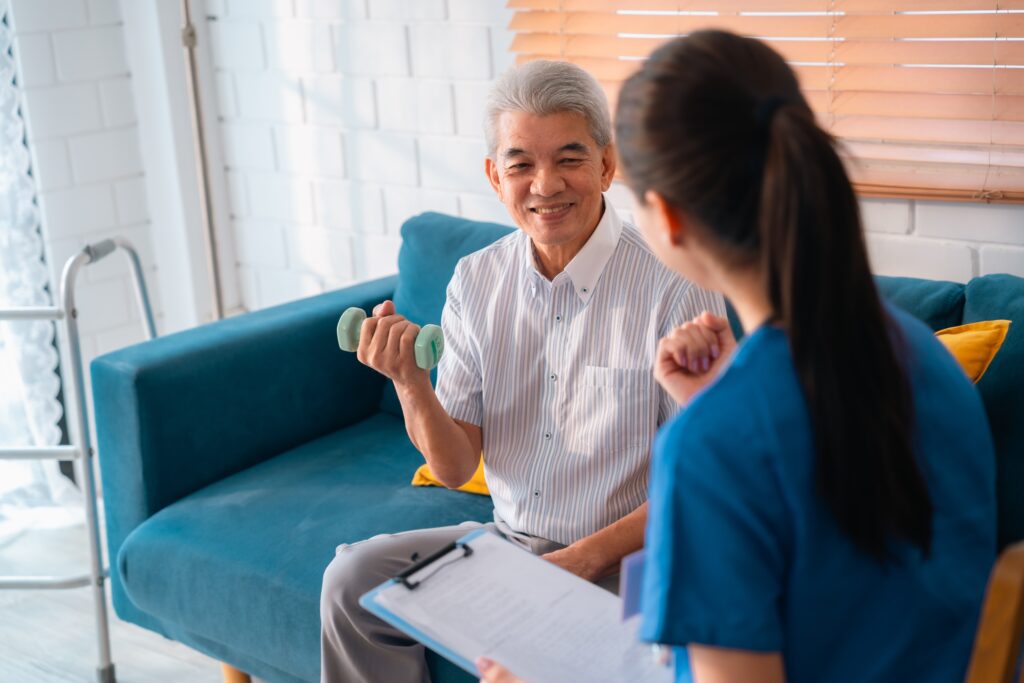The golden years should be a time to embrace newfound freedom, pursue lifelong passions, and cherish cherished relationships. However, the natural aging process can sometimes bring about challenges that threaten an individual’s independence and overall well-being. Fortunately, by adopting a proactive approach to healthy aging, seniors can maintain their vigor, vitality, and zest for life well into their later decades.
This article will go into the multifaceted aspects of healthy aging, drawing insights from the latest research and expert recommendations. From optimizing nutrition and physical fitness to safeguarding mental health and fostering social connections, we’ll explore a holistic framework for empowering seniors to thrive. Whether you’re a senior yourself or caring for a loved one, this article will equip you with the knowledge and tools necessary to navigate the exciting journey of vibrant aging.
Nurturing Nutritional Wellness
As we grow older, our nutritional needs and dietary preferences often evolve. Maintaining a balanced, nutrient-dense diet is crucial for supporting overall health, managing chronic conditions, and staving off age-related complications.
Mastering the MyPlate Approach
The United States Department of Agriculture (USDA) has developed the MyPlate framework, a simple yet effective visual guide to help seniors navigate the complexities of healthy eating. This model emphasizes the importance of incorporating a variety of food groups, including:
- Lean proteins (e.g., lean meats, seafood, eggs, beans)
- Fruits and vegetables (aim for a rainbow of colors)
- Whole grains (such as brown rice, whole wheat pasta)
- Low-fat dairy (milk and its alternatives)
By filling your plate according to the MyPlate proportions, you can ensure that you’re meeting your nutrient needs while maintaining a balanced, calorie-conscious diet.
Addressing Age-Specific Nutrient Requirements
As we age, our bodies’ requirements for certain vitamins and minerals may change. Seniors should pay particular attention to ensuring adequate intake of:
- Calcium and vitamin D: Essential for maintaining strong bones and reducing the risk of osteoporosis.
- Vitamin B12: Crucial for healthy red blood cell formation and neurological function.
- Potassium: Helps regulate blood pressure and supports cardiovascular health.
- Fiber: Promotes digestive regularity and may lower the risk of chronic diseases.
Consulting with a healthcare professional or registered dietitian can help you develop a personalized nutrition plan that addresses your unique needs and preferences.
Embracing Food Safety Practices
Older adults are more susceptible to foodborne illnesses, making food safety a critical consideration for healthy aging. Adopt the following practices to minimize your risk:
- Thoroughly cook meats, poultry, and seafood to the recommended internal temperatures.
- Refrigerate perishable foods promptly and maintain proper food storage temperatures.
- Wash hands, utensils, and surfaces frequently to prevent cross-contamination.
- Avoid consuming unpasteurized dairy products, raw sprouts, and undercooked eggs.
By prioritizing food safety, you can enjoy the nourishing benefits of a well-balanced diet while safeguarding your health.
Optimizing Physical Activity

Regular physical activity is a cornerstone of healthy aging, offering a multitude of benefits that can help seniors maintain their independence and improve their quality of life.
Incorporating a Diverse Exercise Regimen
Aim to incorporate a variety of exercise modalities into your routine, including:
- Aerobic activities (e.g., brisk walking, swimming, cycling) to strengthen the cardiovascular system
- Strength training (such as resistance bands or light weights) to build and maintain muscle mass
- Balance exercises (e.g., tai chi, yoga) to improve stability and reduce the risk of falls
- Flexibility exercises (such as stretching) to maintain joint mobility and range of motion
Experts recommend that older adults engage in at least 150 minutes of moderate-intensity aerobic activity per week, along with muscle-strengthening activities at least two days a week.
Adapting to Physical Limitations
For seniors with mobility challenges or chronic health conditions, regular exercise may seem daunting. However, there are numerous adaptations and alternatives that can help you stay active while accommodating your unique needs:
- Chair-based exercises: Movements performed while seated, such as chair yoga or seated marching, can provide a low-impact workout.
- Assistive devices: Walkers, canes, or resistance bands can provide stability and support during physical activity.
- Water-based exercises: Swimming, water aerobics, or water walking offer a gentle, joint-friendly workout.
- Gradual progression: Start with short, manageable sessions and gradually increase the duration and intensity as your fitness improves.
Consult with a healthcare professional or physical therapist to develop a personalized exercise plan that aligns with your abilities and goals.
Fostering Motivation and Accountability
Maintaining a consistent exercise routine can be a challenge, even for the most dedicated individuals. To stay motivated and accountable, consider the following strategies:
- Find an exercise buddy or join a senior fitness class to foster social engagement and shared accountability.
- Set achievable, incremental goals and celebrate your progress along the way.
- Incorporate activities you genuinely enjoy, whether it’s dancing, gardening, or walking with a beloved pet.
- Track your progress using a fitness tracker or mobile app to stay motivated and monitor your improvements.
By making physical activity an integral part of your lifestyle, you’ll reap the countless benefits of an active, healthy aging journey.
Safeguarding Mental Wellbeing
Cognitive health and emotional resilience are equally vital components of holistic wellness as we grow older. Prioritizing mental wellbeing can help seniors navigate the natural changes and challenges associated with aging.
Nurturing Brain Health
Keeping your mind active and engaged is essential for maintaining cognitive function and potentially delaying the onset of age-related conditions, such as Alzheimer’s disease and dementia.
Engage in activities that challenge your brain and stimulate new neural pathways, such as:
- Learning a new skill (e.g., a musical instrument, a foreign language, or a craft)
- Solving puzzles, playing strategy games, or engaging in mental exercises
- Reading books, magazines, or engaging in lifelong learning opportunities
- Participating in social activities that require mental agility, such as book clubs or trivia nights
Incorporating these brain-boosting activities into your daily routine can help you stay sharp, adaptable, and resilient as you age.
Prioritizing Emotional Wellbeing
Emotional health is just as crucial as physical health when it comes to vibrant aging. Seniors may face increased risk of loneliness, depression, and anxiety due to factors such as social isolation, loss of loved ones, or the onset of chronic health conditions.
To safeguard your emotional wellbeing, consider the following strategies:
- Cultivate a strong social support network by engaging with family, friends, and community groups.
- Practice stress management techniques, such as meditation, deep breathing, or journaling, to manage anxiety and promote inner calm.
- Seek professional help from a mental health provider if you’re experiencing persistent feelings of sadness, hopelessness, or emotional distress.
- Engage in activities that bring you joy and a sense of purpose, whether it’s volunteering, pursuing a hobby, or spending time in nature.
By prioritizing both cognitive and emotional wellbeing, you can foster a holistic approach to healthy aging that supports your overall quality of life.
Navigating Medication Management

Proper medication management is a crucial aspect of healthy aging, as seniors often take multiple prescription and over-the-counter drugs to manage chronic conditions or alleviate age-related symptoms.
Avoiding Common Medication Mistakes
Seniors are particularly vulnerable to medication-related errors, which can have serious consequences for their health and wellbeing. To minimize these risks, be mindful of the following:
- Polypharmacy: Work closely with your healthcare providers to review your medication regimen and identify any potential interactions or duplications.
- Proper dosing: Ensure that you’re taking the correct dosage of each medication, as older adults may require lower doses due to changes in metabolism and organ function.
- Medication interactions: Be aware of potential interactions between your prescription drugs, over-the-counter medications, and dietary supplements.
- Driving and medication: Some medications can impair cognitive function and increase the risk of accidents, so discuss any concerns with your doctor.
Developing a Medication Management System
Staying organized and keeping track of your medications is essential for ensuring safe and effective use. Consider implementing the following strategies:
- Maintain a comprehensive medication list, including the name, dosage, and frequency of each drug, as well as any relevant notes or instructions.
- Use a pillbox or other organizational tool to help you stay on top of your daily medication regimen.
- Set reminders or alarms to help you remember when to take your medications.
- Communicate openly with your healthcare providers about any changes in your medication use or any adverse effects you may be experiencing.
By taking an active role in your medication management, you can optimize the benefits of your prescribed treatments while minimizing the risks.
Embracing Preventive Healthcare
Regular health screenings and preventive care are essential for detecting potential health issues early, when treatment is most effective. As a senior, it’s crucial to stay up-to-date on the recommended preventive services and screenings.
Staying Current with Recommended Screenings
Work closely with your healthcare provider to ensure that you’re receiving the appropriate screenings for your age, gender, and risk factors. Some key preventive screenings for seniors include:
- Mammograms for breast cancer detection
- Colorectal cancer screenings (e.g., colonoscopy, stool tests)
- Bone density scans to assess osteoporosis risk
- Vaccinations, such as the flu shot and pneumococcal vaccine
- Regular eye exams and hearing tests
By proactively participating in these preventive measures, you can take a proactive approach to maintaining your health and identifying any potential issues before they become more serious.
Advocating for Your Healthcare Needs
As an active participant in your own care, you can play a vital role in ensuring that you receive the best possible medical attention. Consider the following strategies:
- Communicate openly with your healthcare providers about your concerns, symptoms, and treatment preferences.
- Ask questions and seek clarification if you’re unsure about any aspect of your care or treatment plan.
- Maintain a comprehensive medical history and be prepared to provide relevant information during appointments.
- Consider involving a trusted family member or caregiver in your healthcare decisions to serve as an advocate and support system.
By taking an active role in your healthcare, you can help ensure that your needs are met and that you receive the personalized, high-quality care you deserve.
Fostering Social Connections
Social engagement and a sense of community are vital for healthy aging, as they can help combat loneliness, improve mental health, and even enhance physical wellbeing.
Combating Social Isolation
Older adults are particularly vulnerable to social isolation and loneliness, which can have detrimental effects on their overall health and quality of life. To combat these challenges, consider the following strategies:
- Regularly connect with family and friends through phone calls, video chats, or in-person visits.
- Participate in community-based activities, such as senior centers, religious organizations, or volunteer groups.
- Explore new hobbies or interests that allow you to meet and interact with like-minded individuals.
- Utilize local resources, such as the Eldercare Locator, to connect with support services and social programs in your community.
By maintaining a robust social network and engaging in meaningful interactions, you can mitigate the negative impacts of isolation and foster a sense of belonging.
Cultivating Intergenerational Connections
Bridging the generational gap can be a powerful way to enrich your social life and share valuable life experiences. Consider the following ways to foster intergenerational connections:
- Volunteer with youth-focused organizations, such as mentoring programs or after-school activities.
- Participate in family gatherings or events that bring together people of all ages.
- Engage in activities that allow you to share your wisdom and expertise, such as teaching a skill or leading a workshop.
- Seek out opportunities to collaborate with younger generations on community projects or initiatives.
By embracing intergenerational relationships, you can not only provide support and guidance to younger individuals but also benefit from the energy, creativity, and fresh perspectives they bring to the table.
Embracing Assistive Technologies
Advancements in technology have revolutionized the way we approach healthy aging, offering a wide range of tools and solutions to enhance independence, safety, and quality of life for seniors.
Harnessing the Power of Telehealth
The COVID-19 pandemic has accelerated the adoption of telehealth services, which allow seniors to access healthcare remotely and minimize the need for in-person visits. Explore the following telehealth options:
- Virtual consultations with healthcare providers for routine check-ups, medication management, or chronic condition monitoring.
- Remote physical therapy or occupational therapy sessions to maintain mobility and independence.
- Teletherapy or virtual support groups for mental health and emotional wellbeing.
By leveraging telehealth services, seniors can receive personalized care from the comfort of their homes, reducing the burden of transportation and ensuring continuous access to essential healthcare services.
Exploring Assistive Devices and Smart Home Technologies
A growing array of assistive technologies and smart home solutions can help seniors maintain their independence and safety. Consider the following options:
- Mobility aids, such as walkers, canes, or motorized scooters, to enhance physical mobility.
- Home automation systems, including voice-controlled smart speakers or motion-activated lighting, to simplify daily tasks.
- Personal emergency response systems (PERS) that allow seniors to call for help in the event of a fall or medical emergency.
- Medication management tools, such as pill organizers or automated dispensers, to ensure proper medication adherence.
By incorporating these assistive technologies into your daily life, you can promote aging in place, reduce the risk of accidents or injuries, and maintain a greater sense of autonomy and control over your living environment.
Embracing a Positive Mindset

Cultivating a positive, optimistic outlook is a powerful tool for healthy aging, as it can have a profound impact on both physical and mental wellbeing.
The Power of Positive Thinking
Research has shown that a positive attitude can extend lifespan by as much as 7.5 years, even after accounting for factors such as gender, wealth, and overall health. Adopting a more optimistic mindset can:
- Boost your resilience and ability to cope with the challenges of aging
- Improve your physical health by encouraging healthier behaviors, such as regular exercise and a nutritious diet
- Enhance your mental and emotional wellbeing, reducing the risk of depression and anxiety
To foster a more positive mindset, try the following strategies:
- Reframe negative thoughts and focus on the good in your life
- Practice gratitude by keeping a journal or sharing your appreciation with others
- Surround yourself with positive, uplifting people who support your growth and happiness
- Engage in activities that bring you joy and a sense of purpose
Embracing Lifelong Learning
Continuous learning and intellectual stimulation are crucial for maintaining cognitive function and fostering a sense of purpose as you age. Embrace the following opportunities for lifelong learning:
- Enroll in classes or workshops at a local community college or senior center
- Explore online courses, educational podcasts, or virtual lectures on topics that interest you
- Join a book club or discussion group to engage in thought-provoking conversations
- Volunteer or work part-time in a field that allows you to share your knowledge and expertise
By continuously challenging your mind and exploring new areas of interest, you can keep your brain active, engaged, and adaptable throughout the aging process.
Participating in Clinical Trials
As you embark on your healthy aging journey, consider the valuable opportunity to contribute to scientific research by participating in clinical trials. By volunteering for these studies, you can not only potentially benefit your own health but also help advance the understanding and treatment of age-related conditions.
Clinical trials are designed to evaluate the safety and effectiveness of new medications, therapies, or interventions. Older adults, in particular, are often underrepresented in these studies, despite being the population that stands to benefit the most from the advancements made.
By participating in a clinical trial, you can:
- Access cutting-edge treatments or therapies that may not yet be available to the general public
- Receive personalized medical attention and close monitoring from healthcare professionals
- Contribute to the development of new and improved interventions for age-related health conditions
- Gain a sense of purpose and empowerment by being an active participant in your own healthcare and the advancement of scientific knowledge
To explore clinical trial opportunities in your area, visit the National Institutes of Health’s ClinicalTrials.gov website or speak with your healthcare provider. By taking an active role in clinical research, you can play a vital part in shaping the future of healthy aging.
Conclusion

Embracing vibrant aging is a multifaceted journey that requires a holistic approach to maintaining physical, mental, and social wellbeing. By incorporating the strategies outlined in this comprehensive guide, seniors can empower themselves to live longer, healthier, and more fulfilling lives.
From optimizing nutrition and physical activity to safeguarding mental health and fostering social connections, the key to successful aging lies in adopting a proactive, personalized approach. Furthermore, leveraging advancements in technology, preventive healthcare, and clinical research can further enhance one’s ability to thrive in the golden Embrace the opportunities that come with aging, and embark on a journey of self-discovery, personal growth, and meaningful engagement. Remember, the later stages of life can be some of the most rewarding, as you have the wisdom, time, and freedom to pursue your passions and deepen your connections with loved ones.
Lastly, healthy aging is not just about maintaining physical health, but also cultivating a positive mindset, nurturing social relationships, and finding a sense of purpose. By embracing this holistic approach, you can unlock the full potential of your golden years and live each day with vitality, resilience, and joie de vivre.